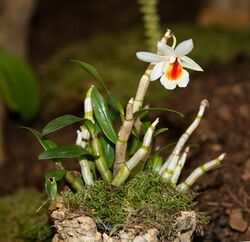Biology:Dendrobium christyanum
| Dendrobium christyanum | |
|---|---|

| |
| Dendrobium christyanum | |
| Scientific classification | |
| Kingdom: | Plantae |
| Clade: | Tracheophytes |
| Clade: | Angiosperms |
| Clade: | Monocots |
| Order: | Asparagales |
| Family: | Orchidaceae |
| Subfamily: | Epidendroideae |
| Genus: | Dendrobium |
| Species: | D. christyanum
|
| Binomial name | |
| Dendrobium christyanum | |
| Synonyms[3] | |
| |
Dendrobium christyanum is a species of orchid (Orchidaceae) endemic to the Chinese island of Hainan.[4][5]
It produces a volatile organic compound that is unrecorded in other plant species. The flowers of this orchid produce a bee pheromone which attracts its pollinator, Vespa bicolor, a species of hornet. The novel feature, first reported in 2009, is supposed to mimic the distress pheromone of the indigenous Asian honey bee Apis cerana (the same chemical as in the European Apis mellifera, which does not occur naturally on Hainan). The chemical compound, (Z)-11-eicosen-1-ol, can be detected by the hornet and is it is assumed this mimicry deceives the insect into visiting the flower without reward (the flowers offer no nectar). V. bicolor preys on honey bees to feed its larvae. The European beewolf (Philanthus triangulum) is also able to detect this compound when hunting bees.[6]
References
- ↑ China Plant Specialist Group. 2004. Dendrobium sinense. The IUCN Red List of Threatened Species 2004. Downloaded on 11 September 2015.
- ↑ "Dendrobium christyanum". International Plant Names Index. https://beta.ipni.org/n/627084-1. Retrieved 2018-11-12.
- ↑ "Dendrobium christyanum Rchb.f.". Royal Botanical Gardens Kew. https://powo.science.kew.org/taxon/urn:lsid:ipni.org:names:627084-1. Retrieved 2018-11-18.
- ↑ Kew World Checklist of Selected Plant Families
- ↑ Flora of China v 25 p 392, 华石斛 hua shi hu, Dendrobium sinense Tang & F. T. Wang, Acta Phytotax. Sin. 12: 41. 1974.
- ↑ Orchid Mimics Honey Bee Alarm Pheromone in Order to Attract Hornets for Pollination, Current Biology, Volume 19, Issue 16, 1368 – 1372, 6 August 2009, doi:10.1016/j.cub.2009.06.067
Wikidata ☰ Q15453104 entry
 |


